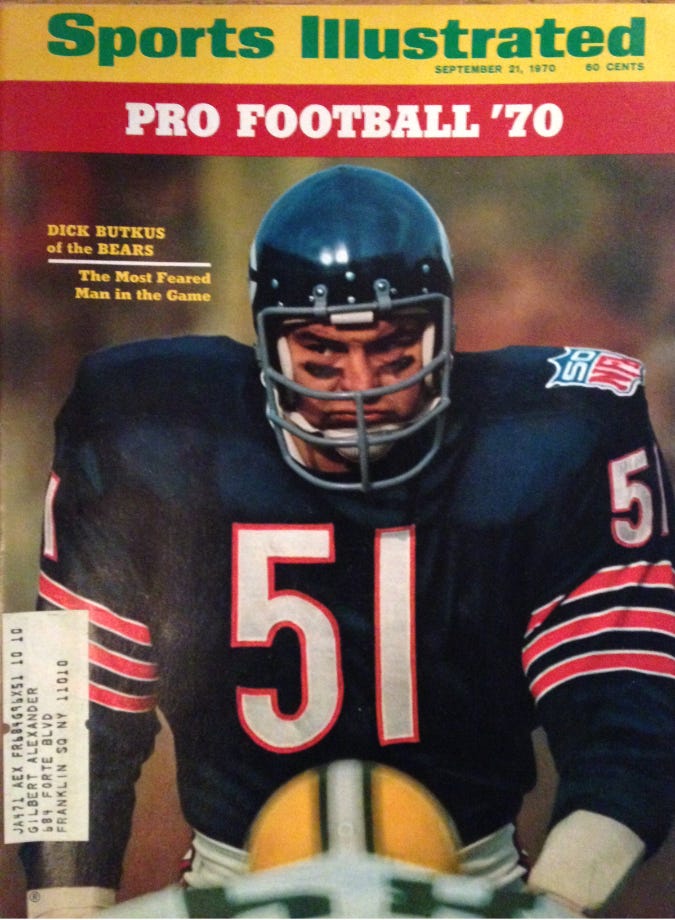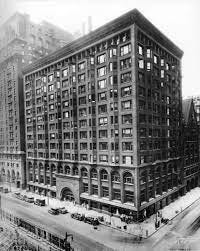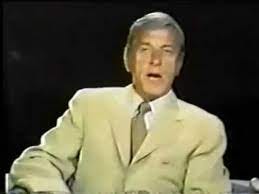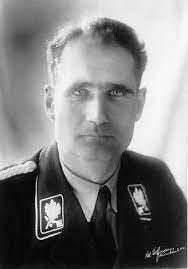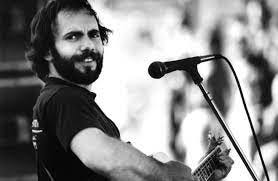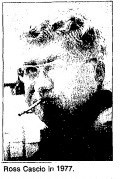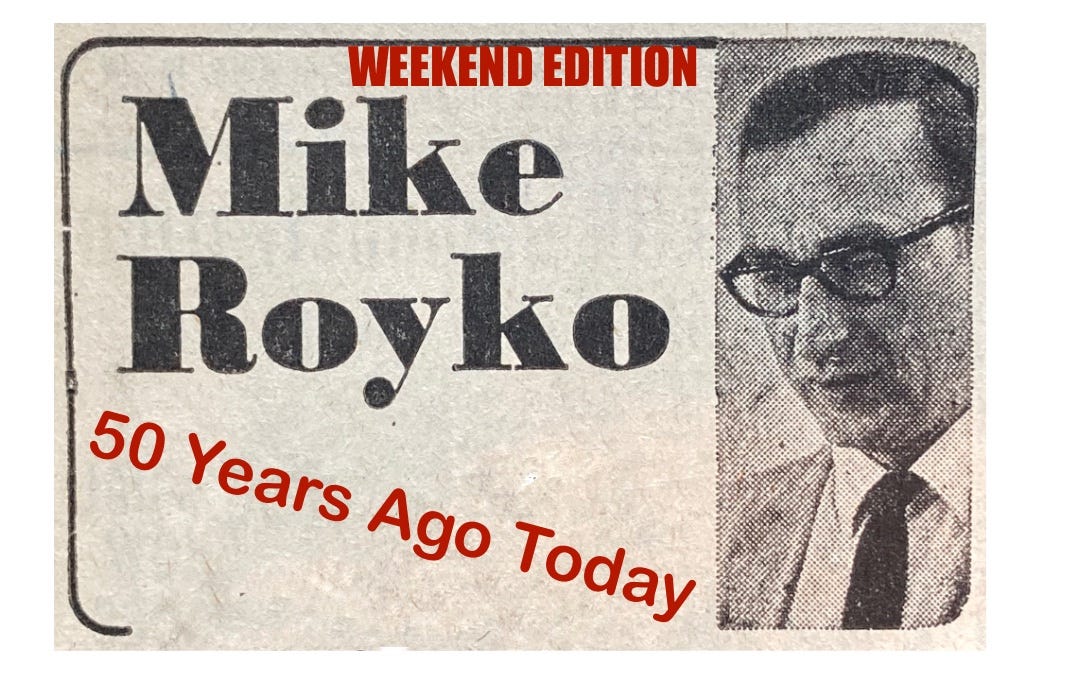Mike Royko 50 Years Ago Today: Town & Country Magazine's Twilight Zone version of Chicago
Weekly Compilation January 24-30, 1972
To access other parts of this site, click here for the Home Page.
Why do we run this separate item, Mike Royko 50 Years Ago Today? Because Steve Bertolucci, the hero of the serialized novel central to this Substack, “Roseland, Chicago: 1972,” lived in a Daily News household. The Bertolucci’s subscribed to the Daily News, and back then everybody read the paper, even kids. And if you read the Daily News, you read Mike Royko. Read the daily Royko briefing Monday-Friday on Twitter, @RoselandChi1972.
January 24, 1972
Chicago passes blue-blood test
Mike reads the latest Town and Country magazine, with a spread on Chicago. “I don’t know why,” says Mike. “ Maybe Town and Country fears that the jet set will be hijacked to Midway Airport and wants to be prepared.”
Author Ted Burke interviewed Chicago’s 1972 elite, such as Bonnie Swearingen, wife of Standard Oil’s board chairman. “Burke considers Mrs. Swearingen, who has lived here all of three years, to be an authority on Chicago,” writes Mike. “She confided to Burke: ‘I eat natural honey with the honeycombs, especially before making love. That is what athletes take before a big game.’”

Mike is puzzled: “Dick Butkus told me he goes to church before a big game. But not all athletes have the same training schedule.”
But most puzzling are Town and Country’s observations when Ted Burke looks at “the rest of us.”
“He has concluded that life for the masses in Chicago is almost too good to bear. Naturally he gives most of the credit to—who else?—Mayor Richard J. Daley.”
Just two examples of Town and Country versus Mike Royko:
T&C: “Last year when the number of major crimes in the U.S. rose 11 per cent, Chicago’s rate dropped 3 per cent, thanks to an effective police force.”
Mike: “Thanks most of all to an effective juggling of crime statisics. You can get your throat slit in Chicago and be listed as a shaving mishap.”
(On November 30, Mike wrote about the latest official crime statistics: “Mayor Daley says it proves we have the best police department and citizens. I have a different idea. We lie.”)
T&C: “The one art form that has always flourished in local soil is architecture. Sullivan, Wright and Mies van der Rohe—the giants of our age—made the Chicago of the 30s and 40s the Athens of the new world, a title it still enjoys.”
Mike: “Burke failed to mention that the world’s architects have watched in horror as the works of Wright and Sullivan have been bulldozed by the city’s hustlebuck real estate men, with the approval of City Hall.”
January 25, 1972
A victim of hit and runaround
Mike tells the tale of Ron Denardo, from LaPorte, IN, who gets off 294 at Dempster for a quick bite and almost gets into a head-on crash with some idiot driving full speed on the wrong side of the road.
Denardo swerved just in time but still got side-swiped.
“When Denardo got over the shakes, he saw the other driver was gone. He hadn’t even slowed down. But another motorist pulled over and said he had some of the numbers from the hit-run car’s license plate.”
Now Denardo will enter a suburban Twilight Zone, shunted from the nearby sheriff’s office to Mt. Prospect police, to Niles police, back to Mt. Prospect, and back again to Niles—because nobody wants to admit the accident happened in their jurisdiction.
Finally Niles admits it’s theirs and takes the info. It's been four hours and they tell Denardo they’ll never catch the guy anyway—he had too much time to get away.
Denardo gets the last word today: “If I had been hurt, they would have probably put me on a stretcher and spent the rest of the afternoon passing me around like a plate of butter.”
January 26, 1972
Hess fan club draws a blank
Mike finds eccentrics are dwindling. Timothy Leary has “fled the country,” the Weathermen are in hiding, “still miffed that the nation would not follow a bunch of suburban youths into revolution,” and “Even Howard Miller is off the air.”
Things are so desperate, some maniacs have “taken up the cause of freeing Rudolph Hess.” Mike reminds us that Rudolph Hess was Hitler’s deputy fuehrer, who suddenly got in a plane and flew to England in 1941. After the war Hess was sentenced to prison during the Nuremberg trials, and he’s still behind bars in Berlin’s Spandau Prison.
The “Freedom for Rudolph Hess Association” is spreading pamphlets around, and Mike has one. “He may very well leave Spandau Prison in a pine box without having had the taste of freedom for as long as most of us have been on this earth,” it reads.
Mike drives out to the address on the pamphlet, an apartment building in Rosemont. Nobody there knows anything about it. Mike says Hess probably won’t get out of prison at this rate, and it’s his own fault.
“If he had had the sense to take up a practical trade as a young man—such as rocketry or nuclear weapon design—he would have been paroled long ago, and could have had a nice job here.”
January 27, 1972
Singer, Cascio in alley fight
The Lincoln Park Pirate returns! Sort of. Ross Cascio’s infamous company, Lincoln Park towing, has put locked gates up across the alley dividing two parking lots next to its headquarter at 1301 W. Fullerton.
Mike has been writing about Ross Cascio and Lincoln Park towing since 1967. He put them on the map of Chicago folk villains, so we have Mike to thank for Steve Goodman’s Chicago classic folk song.
Cascio has sued Mike twice for libel and lost. He visited Mike at his Daily News office just last week with his new “PR” man—Pete Harlib, a retired Chicago cop who was desk sergeant at the notorious Summerdale police station.
Today, Ald. Bill Singer, an independent Democrat who is therefore a thorn in Mayor Daley’s side, comes to Mike to report Ross Cascio has blocked the alley, which is in his ward. Singer brings Mike to see. It’s true. They go inside the Lincoln Park towing office, but they’re told Ross Cascio is in the hospital.
Mike calls Cascio’s PR guy, Pete Harlib.
“’Cascio is in the hospital,’ Harlib said. ‘He is in there because things you write about him are ruining his health. You are going to drive him to an early grave, just like you did with his dog….Nobody’s using the alley anyway. What can you do in an alley?’”
January 28, 1972
At least board pays its bills
Another classic case of bureaucrats who make the mistake of telling Mike Royko exactly what they think.
Mike learns that CBI Business Forms at 3322 W. Peterson sends out sample bills to drum up business—but they look pretty real. One of these advertising bills showing a balance of $132.50 went to the Chicago School Board, which paid it, even though the fake bill and check went through the director of the Bureau of Operations and the director of Systems Analysis and Data Processing, who you might think would know better.
Board of Education comptroller Robert Stickles also approved the bill which is really an ad.
Mike asks Comptroller Stickles about it.
“If we didn’t have any goofups, we wouldn’t need any people in this department,” splutters Stickles. "I don’t see where this is such a big deal anyway, so what?”
Mike’s conclusion: “Maybe the school system is hiring it own graduates.”
January 29-30, 1972
Split-Level King of the Playboys
As we here all know, weekends could be sad for a Daily News family because Mike Royko wasn’t in the Daily News’ single weekend edition. So we look for Mike elsewhere on weekends.
Let’s stroll further into Mike’s first book of columns from 1967, Up Against It.
Whoops, we bumped into Hugh Hefner. It’s hard to stroll around Chicago anytime in the ‘50s, ‘60s and ‘70s without running into Hef. It’s sad, but Hugh Hefner was one of the biggest celebrities in town through the ‘70s, after starting Playboy Magazine in 1953.
In 2000, Hefner still had enough pull via daughter Christie Hefner to get an honorary street named for him by the Chicago City Council—Hugh Hefner Way.
There was a little controversy over Hugh Hefner Way, but not enough to stop it. Daughter Christie Hefner, who was president of Playboy Enterprises at the time, said it made Chicago “look provincial.” Sun-Times columnist Cate Plys agreed with her: “It makes us look provincial because we're so hard up for local heroes we have to stoop to honoring a rich pornographer,” she wrote. “It makes us look even more provincial that local hotshots—Cook County Board President John Stroger, to name one—are so hard up for a cocktail party that they all flock to a shindig honoring a rich pornographer.”
Plys noted that then 74-year-old Hefner was in the middle of “touring the country boasting about having sex with twin sisters young enough to be his granddaughters….And the current Playboy features pictures of the twins apparently engaging in sexual relations with each other.”
Playboy, and Hugh Hefner’s boasting, were tamer in the ‘60s. Hefner didn’t have to go full-on incestuous sex to shock people back then. All he had to do was put a swimming pool in his basement, really.
Mike considers Hugh Hefner’s supposedly astounding swinging lifestyle in the ‘60s, and shrugs.
“After looking over the latest big story about Hugh Hefner (in Life magazine), I’m even more convinced that he is the world’s most overrated playboy,” Mike starts.
Mike isn’t even sure Hefner IS a playboy. A real playboy has “sensational affairs with famous actresses, singers, and countesses,” writes Mike. “They squander fortunes at the gambling casinos, hire Broadway casts to entertain at their parties, shoot big game in the jungles and pop corks in the night clubs of the world.”
Now, “along comes Skinny Hugh from the U. of I. and he puts a copyright on” the word “Playboy.”
“What has Hefner done to earn it?” Mike asks.
Mike notes that Hefner claims “I’m living to the furthest extent possible…everything I ever dreamed for myself.” Mike observes that Hefner lives in a Near North Side mansion he “seldom leaves” with a basement swimming pool, a cocktail lounge, a stereo system, and a private movie theater. Granted, he has female companionship.
But, writes Mike, “Except for the fact that it is bigger and all paid for, he’s put together an overgrown split-level, right out of a ‘better homes’ magazine. Hefner’s kingdom is the same kingdom the 5:15 suburban commuter is rushing home to.”
Mike notes that many people have swimming pools and stereos. And whether you’re in Hef’s private movie theater or a Park Ridge family room, “the late show still looks like the late show.”
“Life magazine should have tried my Uncle Rudy, if they were looking for a live wire,” he concludes. “He’s been married four times, pinched in a bookie raid, and he’s the biggest swinger at the over-forty dances. Besides, he wears a red toupee.”
By the way, this feature is no substitute for reading Mike’s full columns. He’s best appreciated in the clear, concise, unbroken original version. Mike already trimmed the verbal fat, so he doesn’t need to be summarized Reader’s Digest-style, either. Our purpose here is to give you some good quotes from the original columns, but especially to give the historic and pop culture context that Mike’s original readers brought to his work. You can’t get the inside jokes if you don’t know the references. Plus, many columns didn’t make it into the collections, so unless you dive into microfilm, there are some columns covered here you will never read elsewhere. If you don’t own any of Mike’s books, maybe start with “One More Time,” a selection covering Mike’s entire career and including a foreword by Studs Terkel and commentaries by Lois Wille.
Do you dig spending some time in 1972? If you came to MIKE ROYKO 50 YEARS AGO TODAY from social media, you may not know it’s part of the book being serialized here, one chapter per month: “Roseland, Chicago: 1972.” It’s the story of Steve Bertolucci, 10-year-old Roselander in 1972, and what becomes of him. Check it out here.
To get the weekly compilation of MIKE ROYKO 50 YEARS AGO TODAY in your mailbox along with THIS CRAZY DAY IN 1972 and new chapters of the book, SUBSCRIBE FOR FREE!




